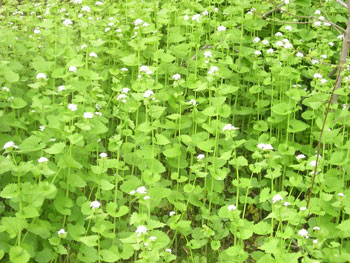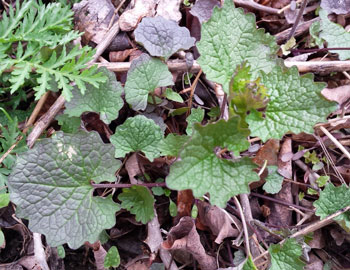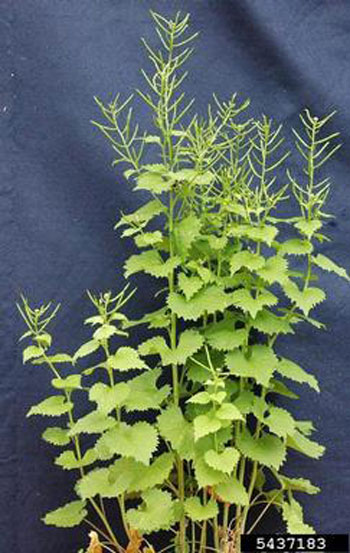DACF Home → Bureaus & Programs → Maine Natural Areas Program → Communities, Plants, and Animals → Invasive Plants → Garlic Mustard
 Garlic Mustard
Garlic Mustard
Garlic Mustard
Alliara petiolata
2019 Status in Maine: Localized. Severely Invasive.
Description: Erect biennial herb. First year plants grow as low rosettes; second year plants grow leafy flowering stems up to 3' tall. Leaves: First year leaves are coarsely toothed and kidney shaped, 1-4" long, and form a basal rosette that overwinters. Second year leaves are alternate and coarsely toothed, varying from more kidney-shaped leaves toward the ground to more triangular leaves higher up on the stem. Crushed leaves smell like garlic. Flowers/Seeds: Abundant ¼" white, 4-petaled flowers, produced form April-June, in its second year. Skinny seed capsules 1-2½" split open in mid to late summer releasing tiny black seeds, several hundred per plant on average. Root: Tap root is white and is often S-shaped near the stem.
Native range: Europe. How arrived in U.S.: Brought by European settlers for food.
Reproduction: By seed dispersed via water, gravity, or in mud or animal fur. After cold stratification, most seeds germinate the first spring (April). Those that do not can remain viable for up to 6 years.
Habitat: Shade tolerant and adaptable. Floodplains, upland forests, and disturbed edges.
 First year leaves and rosette of garlic mustard
First year leaves and rosette of garlic mustard
Similar native species: Violets (Viola spp).
Similar non-native species: Ground ivy (Glechoma hederacea) and other introduced mustards.
Fact Sheets and Identification Links
- Vermont Fact Sheet and Species Spotlight for Garlic Mustard
- University of Wisconsin, Identification Video (2:23)
- Go Botany page for Alliaria petiolata
Control Methods
Plant is edible and easy to hand pull, especially from moist ground. Second-year plants that have begun to flower should be bagged and removed as seeds can still mature.* Weed torch, weather permitting, is another effective option. Larger populations can be mowed in late spring; repeat for 3-5 years to deplete seed bank. First-year rosettes can be controlled with a solution of triclopyr ester formulation or glyphosate†; second year plants must be sprayed well before seed set. This plant flowers early in the spring with the flush of other invasive plants like barberry and honeysuckles. Be prepared for an early intervention to control seed set.
 Garlic mustard, 2nd year plants in fruit. Bruce Adkley, The Ohio State University, Bugwood.org
Garlic mustard, 2nd year plants in fruit. Bruce Adkley, The Ohio State University, Bugwood.org
Control Technique Video Demonstrations
- Hemdon Environmental Network, Virginia (3:45), eating, hand pulling, and disposal
Please email invasives.mnap@maine.gov if you have questions about invasive species in Maine